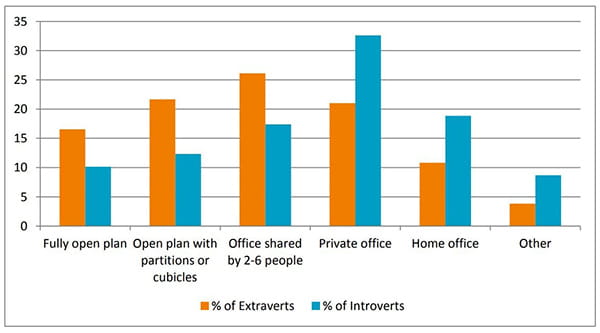Together, not together
John Hackston, Head of Thought Leadership, OPP
It’s been established for some time that most people don’t like open-plan offices. When we carried out our research into MBTI type and office environment back in 2015, we found that Extraverts mostly preferred small group offices and Introverts mostly preferred a private office or a home office, but that few people of any type preference put working in a fully open-plan office as their top choice.
Preferred office environment

Despite this, open-plan offices are very appealing to organisations. The financial advantages are clear; more employees can be housed more cheaply in a smaller space. However, it has also been claimed that there is more communication between employees in open-plan offices, although there has been no real evidence to support this, and some research that suggests the opposite. Now, two new studies have directly tested how much employees communicated with each before and after their offices were re-organised into an open-plan layout.
The result? In the open-plan layout, people spent over 70% less time interacting face-to-face and 20% to 75% more time using email and instant messenger. Open-plan offices reduce, not increase, the amount of face-to-face communication that goes on. So, if your employer suggests that changing your work environment to an open-plan layout will make everyone happier and more verbally communicative, don’t believe them. There may be perfectly good financial reasons for having open-plan offices, especially in crowded and expensive city centre locations, but your workplace won’t suddenly and magically become a hive of exciting and productive conversation; quite the contrary, in fact.
Of course, we are all individuals, with individual differences and particular likes and dislikes, and there are ways to make even open-plan offices more congenial places to work in. We’ve developed a short guide to making the most of your workspace, with some general hints and tips as well as specific ideas for people of different MBTI type preferences. You can download a copy here.